Electrification of a Remote Rural Farm with Solar Energy—Contribution to the Development of Smart Farming
Abstract
:1. Introduction
- SDG2: promote food and sustainable agriculture. The farm has areas for cultivation and pasture capable of providing food (vegetables and legumes) as well as dairy products and meat (cattle, chicken, sheep, etc.) and water for irrigation;
- SDG6: availability of clean water and sanitation. The system has a 10,000 L underground tank whose capacity ensures sanitary and bathing consumption. This capacity depends on the amount of rain that is stored annually;
- SDG7: affordable, reliable, and renewable energy. The rural farm is supplied based on clean alternative energy. It consists of a photovoltaic system supported by a mini hydro and a wind turbine. In the absence of any of the aforementioned renewable energy sources, the farm will continue to operate, as it is connected to the Portuguese electricity distribution network, with an alternative energy source;
- SDG9: industry, innovation, and infrastructure. This system is innovative. The rural farm is fully automated. The implemented system allows remote access to rural farm owners and users, where it is possible to control and monitor, in real time, the proper functioning of domestic and rural equipment associated with the farm and the rural house;
- SDG11: sustainable cities and communities. This project contributes to this SDG through the use of renewable and sustainable energy, which reduces the negative environmental impact per capita in the area where it operates. In addition, it is adapted to climate change due to the reduction of the carbon footprint of the agricultural products. This allows one to make it a smart grid.
2. Development of Sustainable Farms
- Development and implementation of a photovoltaic system for rural and residential automation aimed at real-time control and monitoring of the installation’s equipment.
- Reduction of energy consumption in the rural farm and residence, eliminating dependence on traditional energy sources obtained through fossil means or the conventional electrical grid.
- Continuous monitoring of significant electrical quantities at the farm and residence through real-time visualization pages, enabling analysis and application of corrective measures to maximize the performance of the photovoltaic system.
- Description of the development and implementation of a photovoltaic automation system for real-time control and monitoring of equipment.
- Emphasis on the difficulty of comparing the development and implementation of renewable energy solutions due to the lack of access to confidential technical data.
- Based on comparative analysis with similar solutions, no identical solution exists with the results and technologies obtained through this configuration, allowing for the addition of other renewable energy sources such as wind and hydroelectric power.
- Discussion on the migration, transformation, and implementation of agrivoltaic photovoltaic systems, highlighting the most significant starting points for their construction.
- Evaluation of possible constructions, objectives, problems, and added value in the implementation of agrivoltaic photovoltaic systems.
3. Case Study
3.1. Case Implementation
- Activate or deactivate loads in the house, such as the pump motor that allows water to be collected from underground;
- Activate or deactivate loads such as lighting, blinds, irrigation system, etc.;
- Checking the operation of certain equipment and/or devices at home and abroad;
- Checking the working condition of the various pieces of equipment that make up the house;
- Generate warning signals if any anomaly occurs;
- Send SMSs in case of fire or another anomaly.
3.2. Photovoltaic Generator Sizing
- Nominal power of the photovoltaic generator: 13.0 kW (crystalline silicon);
- Estimated losses due to temperature and low irradiation: 10.8% (using local ambient temperature);
- Estimated loss due to angular reflection effects: 2.6%;
- Other losses (cables, inverters, etc.): 14.0%;
- Losses from the combined photovoltaic system: 25.3%;
- Optimal tilt angle: 36°.
3.3. Photovoltaic System Implemented
3.4. Equipment That Composes the Implemented Photovoltaic System
- Connect and collect measurement values from up to eight measurement modules;
- Prepare data for transmission to higher commands;
- Supply power to the connected measurement modules;
- Eight-channel current measurement up to 20 A DC;
- Detection of reverse currents up to 1 A;
- Four-channel add-on modules for 20 A DC;
- Digital input for monitoring, from the remote signaling contacts of the surge protection modules;
- Power supply via the communication module;
- Voltage measurement up to 1500 V DC in any grounded photovoltaic system;
- Connection and supply normally via the analog input provided by the eight-channel current measurement;
- Solar check current measurement module;
- Output of the voltage measurement value as an analog signal.
3.5. Economic Analysis of the Implemented System
4. Discussion
4.1. Comparison with Similar Cases
4.2. Critical Analysis
- System A supplies energy to the farm equipment and the farmhouse, while System D supplies energy only to the farmhouse. In addition, System A has a high degree of automation of the house and the photovoltaic system implemented, which allows for a significant reduction in the cost of the monthly energy bill;
- System A manages two alternative renewable energy sources, one solar photovoltaic and the other wind or mini hydro. System D has a diesel generator, i.e., a nonrenewable energy source. In addition, System A makes it possible to use the national electricity grid as a backup source of energy in the event of a failure in the supply of any of the renewable energy sources;
- System A will have a lower battery replacement cost in the future, since the installed capacity is lower than that of System D. In addition, System A has a higher capacity percentage (%) of the battery charge rate, with an autonomy for the installed power of 5/6 days, which is very good;
- System A has local/remote control and monitoring for the photovoltaic system as well as for the automated equipment on the farm and in the rural dwelling. System D does not have a degree of automation, remote access, or integrated controls.
4.3. Adaptation to Agrivoltaic Systems
5. Conclusions
6. Future Work
- System optimization: developing enhanced design and deployment techniques for agrivoltaic systems to maximize energy production efficiency while supporting diverse types of crops and varying environmental conditions.
- Economic feasibility studies: conducting comprehensive and detailed analyses on the economic viability of agrivoltaic systems across different scales, considering costs, benefits, and long-term financial impacts for farmers.
- Environmental impact research: investigating environmental impacts, including life cycle assessments, potential carbon emission reductions, and comparative analyses with other renewable energy sources and conventional agricultural methods.
- Adaptation and technological integration: advancing technologies tailored and integrated to enhance the harmonious coexistence of agricultural production and solar energy generation, including innovations in solar tracking systems, support materials, and energy efficiency.
- Standardization and policies: establishing technical standards and guidelines for agrivoltaic system implementation as well as formulating governmental policies and incentives that promote the adoption and expansion of these technologies.
- Monitoring and case studies: conducting detailed studies and long-term monitoring in agrivoltaic farms and test areas to evaluate performance, resilience, and social, economic, and environmental impacts over time.
- Education and awareness: investing in educational programs and awareness campaigns for farmers, rural communities, and policymakers about the benefits, challenges, and best practices related to agrivoltaic systems.
- Addressing technical challenges: tackling technical challenges such as integrating different renewable technologies, energy storage, and smart grid management to optimize the operation of agrivoltaic systems.
Author Contributions
Funding
Data Availability Statement
Conflicts of Interest
References
- European Environment Agency. Global and European Temperatures, June 2023. Available online: https://www.eea.europa.eu/ims/global-and-european-temperatures (accessed on 1 August 2023).
- United Nations. Resolution Adopted by the General Assembly on 6 July 2017, Work of the Statistical Commission Pertaining to the 2030 Agenda for Sustainable Development. Available online: https://digitallibrary.un.org/record/1291226 (accessed on 29 July 2023).
- Ilahi, H.; Hidayat, K.; Adnan, M.; Rehman, F.U.; Tahir, R.; Saeed, M.S.; Shah, S.W.A.; Toor, M.D. Accentuating the Impact of Inorganic and Organic Fertilizers on Agriculture Crop Production: A Review. Indian J. Pure Appl. Biosci. 2021, 9, 36–45. [Google Scholar] [CrossRef]
- Stringer, L.C.; Fraser, E.; Harris, D.; Lyon, C.; Pereira, L.; Ward, C.; Simelton, E. Adaptation and development pathways for different types of farmers. Environ. Sci. Policy 2020, 104, 174–189. [Google Scholar] [CrossRef]
- Olabi, A.; Abdelkareem, M.A. Renewable energy and climate change. Renew. Sustain. Energy Rev. 2022, 158, 112111. [Google Scholar] [CrossRef]
- Lee, S.-I.; Choi, J.-Y.; Sung, S.-J.; Lee, S.-J.; Lee, J.; Choi, W. Simulation and analysis of solar radiation change resulted from solar-sharing for agricultural solar photovoltaic system. J. Korean Soc. Agric. Eng. 2020, 62, 63–72. [Google Scholar] [CrossRef]
- Pereira, F.; Caetano, N.S.; Felgueiras, C. Increasing energy efficiency with a smart farm—An Economic Evaluation. Energy Rep. 2022, 8, 454–461. [Google Scholar] [CrossRef]
- Solargis—Solar Resource Maps of Portugal. Available online: https://solargis.com/maps-and-gis-data/download/portugal (accessed on 6 August 2023).
- Climate Change Knowledge Portugal—For Development Practitioners and Policy Makers. Available online: https://climateknowledgeportal.worldbank.org/country/portugal/climate-data-historical (accessed on 6 August 2023).
- Toshiba. Induction Heating: The Technology Driving Efficiency in HOME Cooking Appliances. Available online: https://toshiba.semicon-storage.com/content/dam/toshiba-ss-v2/master/en/semiconductor/design-development/innovationcentre/whitepapers/TCM0542_GT20N135SRA.pdf (accessed on 29 July 2023).
- Faria, P.; Vale, Z. Demand response in electrical energy supply: An optimal real time pricing approach. Energy 2011, 36, 5374–5384. [Google Scholar] [CrossRef]
- Guerrero, J.M.; Blaabjerg, F.; Zhelev, T.; Hemmes, K.; Monmasson, E.; Jemei, S.; Comech, M.P.; Granadino, R.; Frau, J.I. Distributed Generation: Toward a New Energy Paradigm. IEEE Ind. Electron. Mag. 2010, 4, 52–64. [Google Scholar] [CrossRef]
- Spanaki, K.; Karafili, E.; Despoudi, S. AI applications of data sharing in agriculture 4.0: A framework for role-based data access control. Int. J. Inf. Manag. 2021, 59, 102350. [Google Scholar] [CrossRef]
- Yahya, N. Agricultural 4.0: Its Implementation Toward Future Sustainability. In Green Urea: Green Energy and Technology; Springer: Singapore, 2018; pp. 125–145. [Google Scholar] [CrossRef]
- Brusco, G.; Burgio, A.; Menniti, D.; Pinnarelli, A.; Sorrentino, N. Energy Management System for an Energy District with Demand Response Availability. IEEE Trans. Smart Grid 2014, 5, 2385–2393. [Google Scholar] [CrossRef]
- Lee, S.; Lee, J.-H.; Jeong, Y.; Kim, D.; Seo, B.-H.; Seo, Y.-J.; Kim, T.; Choi, W. Agrivoltaic system designing for sustainability and smart farming: Agronomic aspects and design criteria with safety assessment. Appl. Energy 2023, 341, 121130. [Google Scholar] [CrossRef]
- Pascaris, A.S.; Schelly, C.; Burnham, L.; Pearce, J.M. Integrating solar energy with agriculture: Industry perspectives on the market, community, and socio-political dimensions of agrivoltaics. Energy Res. Soc. Sci. 2021, 75, 102023. [Google Scholar] [CrossRef]
- Zhang, J.; Wang, T.; Chang, Y.; Liu, B. A sustainable development pattern integrating data centers and pasture-based agrivoltaic systems for ecologically fragile areas. Resour. Conserv. Recycl. 2023, 188, 106684. [Google Scholar] [CrossRef]
- Schallenberg-Rodriguez, J.; Rodrigo-Bello, J.-J.; Del Río-Gamero, B. Agrivoltaic: How much electricity could photovoltaic greenhouses supply? Energy Rep. 2023, 9, 5420–5431. [Google Scholar] [CrossRef]
- SMA Solar Technology. Installation—Connection Overview, Multicluster Box 6.3-11. Available online: https://www.europe-solarstore.com/download/sma/sunnyisland/MC-BOX-6-IAU-en-10W.pdf (accessed on 29 July 2023).
- Pereira, F.; Oliveira, M. Curso Técnico Instalador de Energia Solar Fotovoltaica, 2nd ed.; Publindústria: Porto, Portugal, 2015. [Google Scholar]
- Soufi, A.; Chermitti, A.; Mostafa, B.M.; Zehor, A. Investigating the Performance of Chosen Models for the Estimation of Global Solar Radiation on Horizontal Surface—A Case Study in Terny Hdiel, Tlemcen of Algeria. J. Eng. Sci. Technol. Rev. 2014, 7, 45–49. [Google Scholar] [CrossRef]
- Salihu, T.; Akorede, M.; Abdulkarim, A.; Abdullateef, A. Off-grid photovoltaic microgrid development for rural electrification in Nigeria. Electr. J. 2020, 33, 106765. [Google Scholar] [CrossRef]
- Ibrik, I. Micro-Grid Solar Photovoltaic Systems for Rural Development and Sustainable Agriculture in Palestine. Agronomy 2020, 10, 1474. [Google Scholar] [CrossRef]
- IEC 60364-7-712:2017; Low Voltage Electrical Installations—Part 7-712: Requirements for Special Installations or Locations—Solar Photovoltaic (PV) Power Supply Systems, 2.0 ed. International Electrotechnical Commission: Geneva, Switzerland, 2017.
- Alharbi, S.J.; Alaboodi, A.S. A Review on Techno-Economic Study for Supporting Building with PV-Grid-Connected Systems under Saudi Regulations. Energies 2023, 16, 1531. [Google Scholar] [CrossRef]
- Lo, K.; Kibalya, B. Electric cooperatives and the political economy of rural electrification in Africa: Insights from Uganda. Electr. J. 2023, 36, 107238. [Google Scholar] [CrossRef]
- Devine-Wright, P.; Batel, S. Explaining public preferences for high voltage pylon designs: An empirical study of perceived fit in a rural landscape. Land Use Policy 2013, 31, 640–649. [Google Scholar] [CrossRef]
- Poggi, F.; Firmino, A.; Amado, M. Planning renewable energy in rural areas: Impacts on occupation and land use. Energy 2018, 155, 630–640. [Google Scholar] [CrossRef]
- Di Felice, V.; Batista, E.R.d.J.S.B.; Mancinelli, R.; Batista, J.G.F.; Campiglia, E. Rurality and agroecosystem sustainability: A case study at farm-field level in Terceira Island (Portugal) and in Viterbo Province (Italy). Renew. Agric. Food Syst. 2014, 29, 265–276. [Google Scholar] [CrossRef]
- Nakata, H.; Ogata, S. Integrating Agrivoltaic Systems into Local Industries: A Case Study and Economic Analysis of Rural Japan. Agronomy 2023, 13, 513. [Google Scholar] [CrossRef]
- Wagner, M.; Lask, J.; Kiesel, A.; Lewandowski, I.; Weselek, A.; Högy, P.; Trommsdorff, M.; Schnaiker, M.-A.; Bauerle, A. Agrivoltaics: The Environmental Impacts of Combining Food Crop Cultivation and Solar Energy Generation. Agronomy 2023, 13, 299. [Google Scholar] [CrossRef]
- Moradi, M.A.; Salimi, M.; Amidpour, M. Evaluation of agriculture wells electrification policy and development of a long-term sustainable energy strategy. Smart Energy 2023, 10, 100101. [Google Scholar] [CrossRef]
- Enel Green Power: Agrivoltaics: The World of Agriculture Can Reap Numerous Benefits. Available online: https://www.enelgreenpower.com/media/news/2022/12/agrivoltaics-benefits-world-agriculture (accessed on 20 October 2023).
- Liu, W.; Omer, A.A.A.; Li, M. Agrivoltaic: Challenge and Progress. Agronomy 2023, 13, 1934. [Google Scholar] [CrossRef]
- Ramesh, D.; Chandrasekaran, M.; Soundararajan, R.P.; Subramanian, P.P.; Palled, V.; Kumar, D.P. Solar-Powered Plant Protection Equipment: Perspective and Prospects. Energies 2022, 15, 7379. [Google Scholar] [CrossRef]
- Monteiro, C.; Saraiva, J.; Miranda, V. Evaluation of electrification alternatives in developing countries-the SOLARGIS tool. In Proceedings of the Mediterranean Electrotechnical Conference-MELECON, Tel Aviv, Israel, 18–20 May 1998; Volume 2, pp. 1037–1041. [Google Scholar] [CrossRef]
- Martinho, V.J.P.D. Interrelationships between renewable energy and agricultural economics: An overview. Energy Strat. Rev. 2018, 22, 396–409. [Google Scholar] [CrossRef]
- Martinho, V.J.P.D. Best management practices from agricultural economics: Mitigating air, soil and water pollution. Sci. Total. Environ. 2019, 688, 346–360. [Google Scholar] [CrossRef]
- Agrovoltaic, Preserving the Farming Culture: Solar Greenhouses. Available online: https://agrovoltaic.org/solar-greenhouses/ (accessed on 20 October 2023).
- Patel, U.R.; Gadhiya, G.A.; Chauhan, P.M. Case Study on Power Generation from Agrivoltaic System in India. Int. J. Environ. Clim. Chang. 2023, 13, 1447–1454. [Google Scholar] [CrossRef]
- Yajima, D.; Toyoda, T.; Kirimura, M.; Araki, K.; Ota, Y.; Nishioka, K. Estimation Model of Agrivoltaic Systems Maximizing for Both Photovoltaic Electricity Generation and Agricultural Production. Energies 2023, 16, 3261. [Google Scholar] [CrossRef]
- Cieślak, K.J. Multivariant Analysis of Photovoltaic Performance with Consideration of Self-Consumption. Energies 2022, 15, 6732. [Google Scholar] [CrossRef]
- Ceballos, M.A.; Pérez-Higueras, P.J.; Fernández, E.F.; Almonacid, F. Tracking-Integrated CPV Technology: State-of-the-Art and Classification. Energies 2023, 16, 5605. [Google Scholar] [CrossRef]
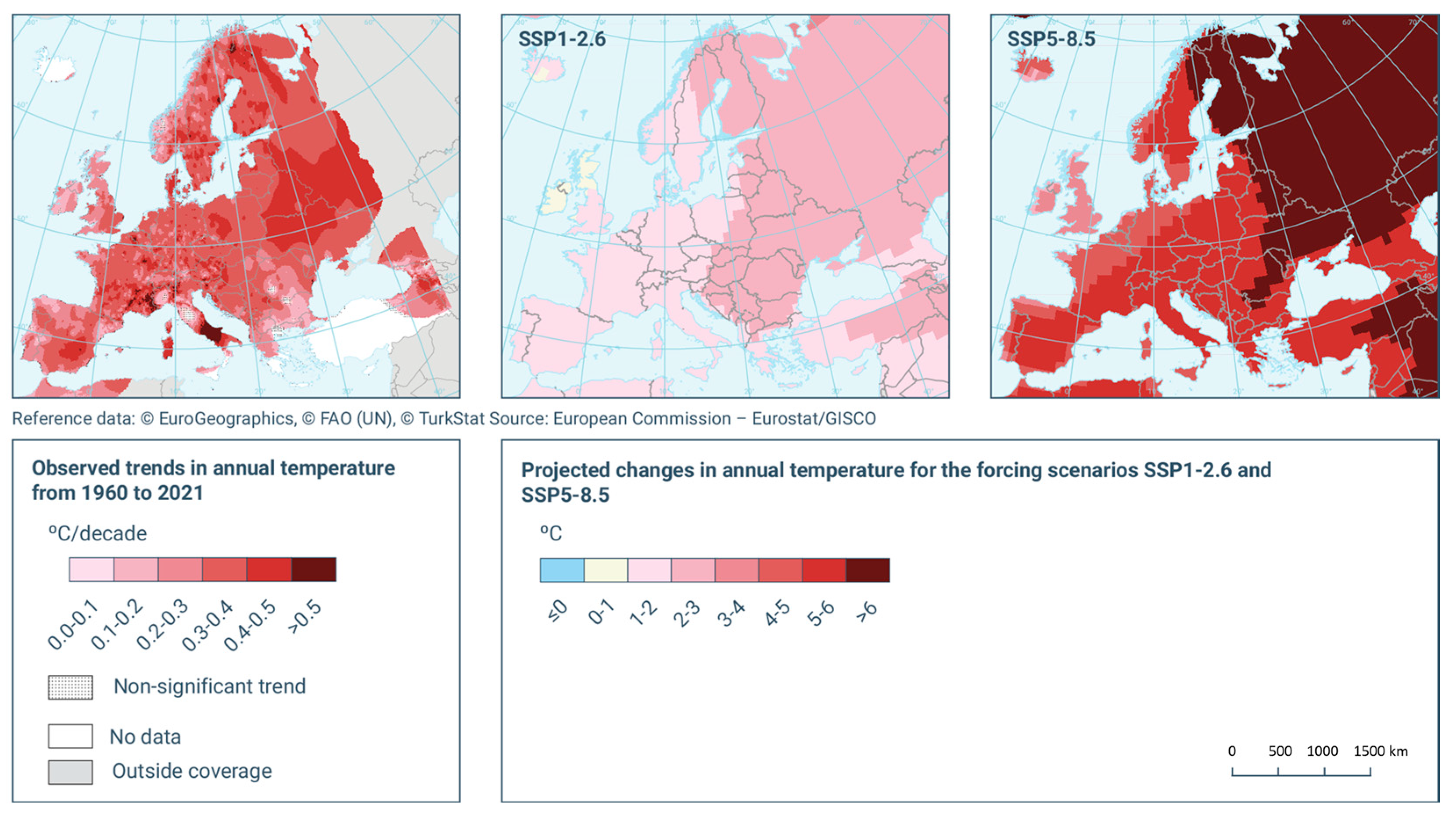
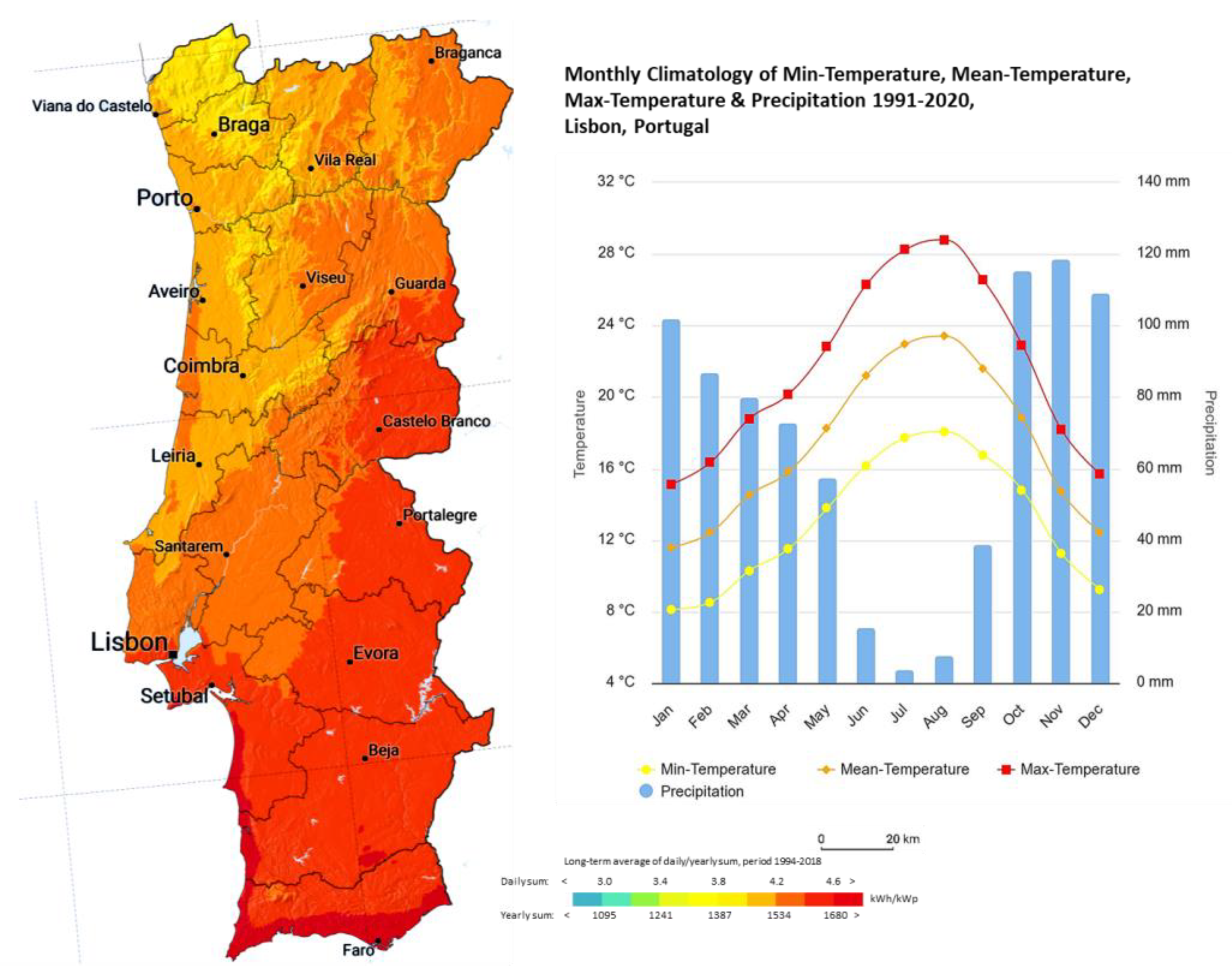
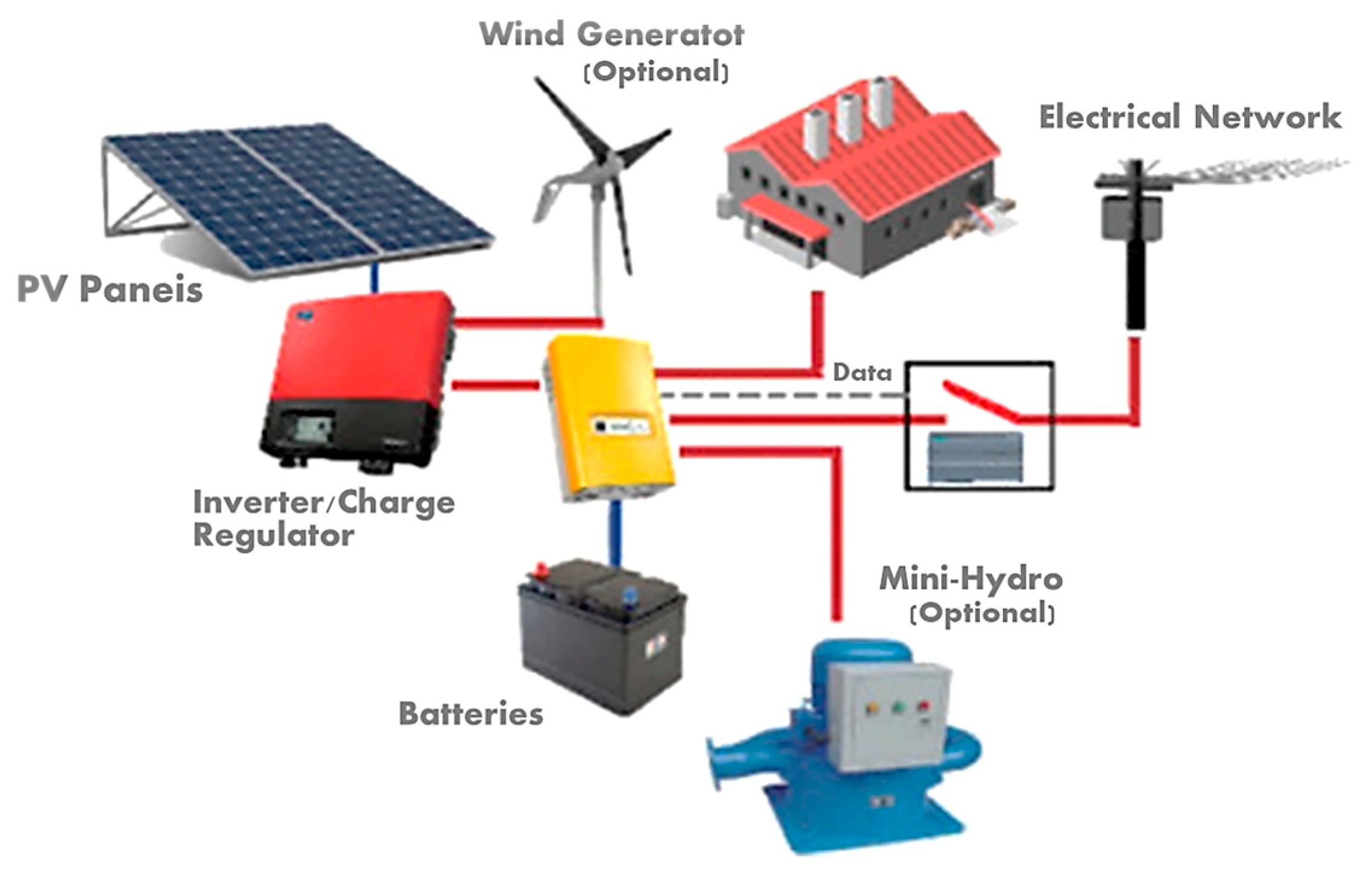
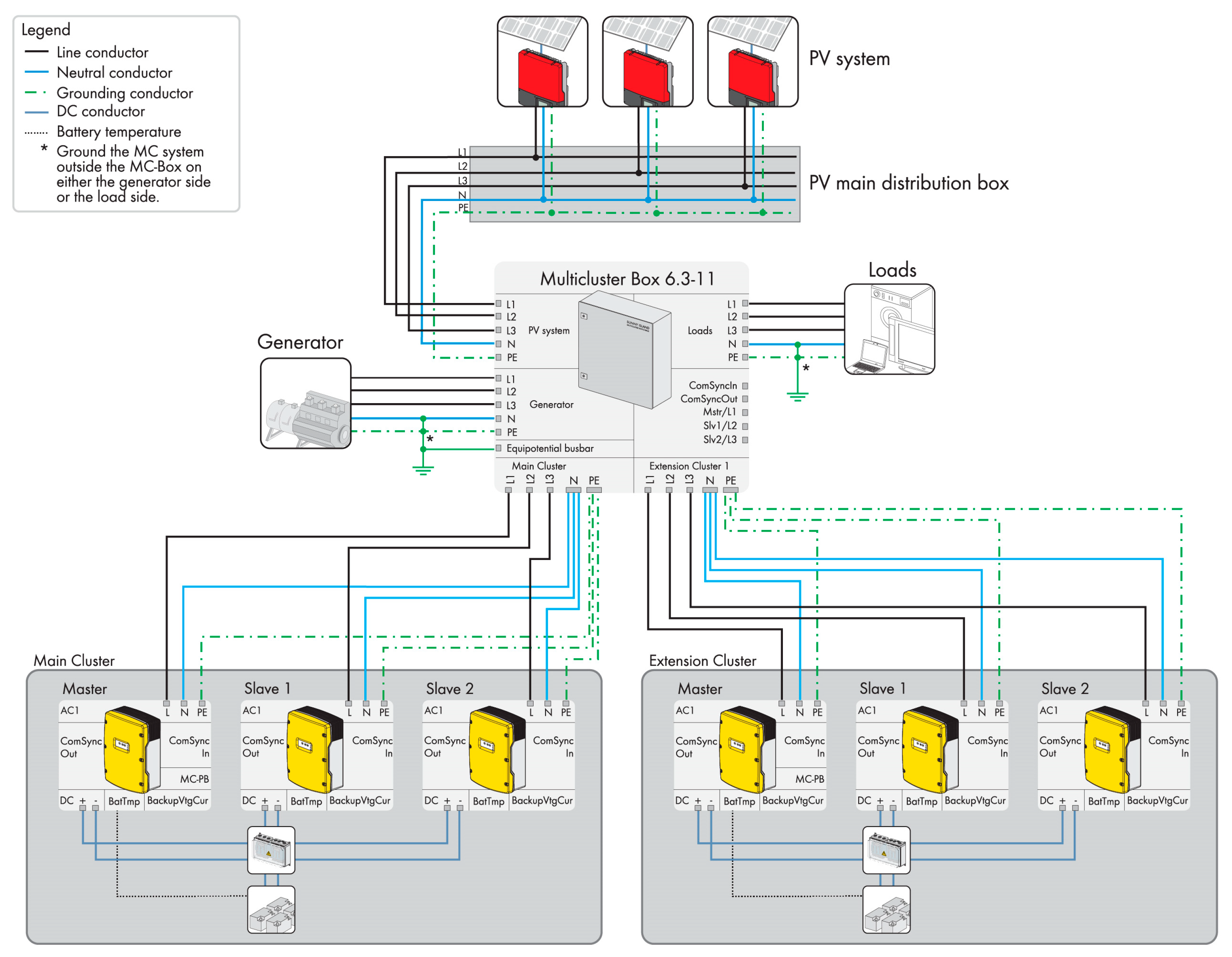
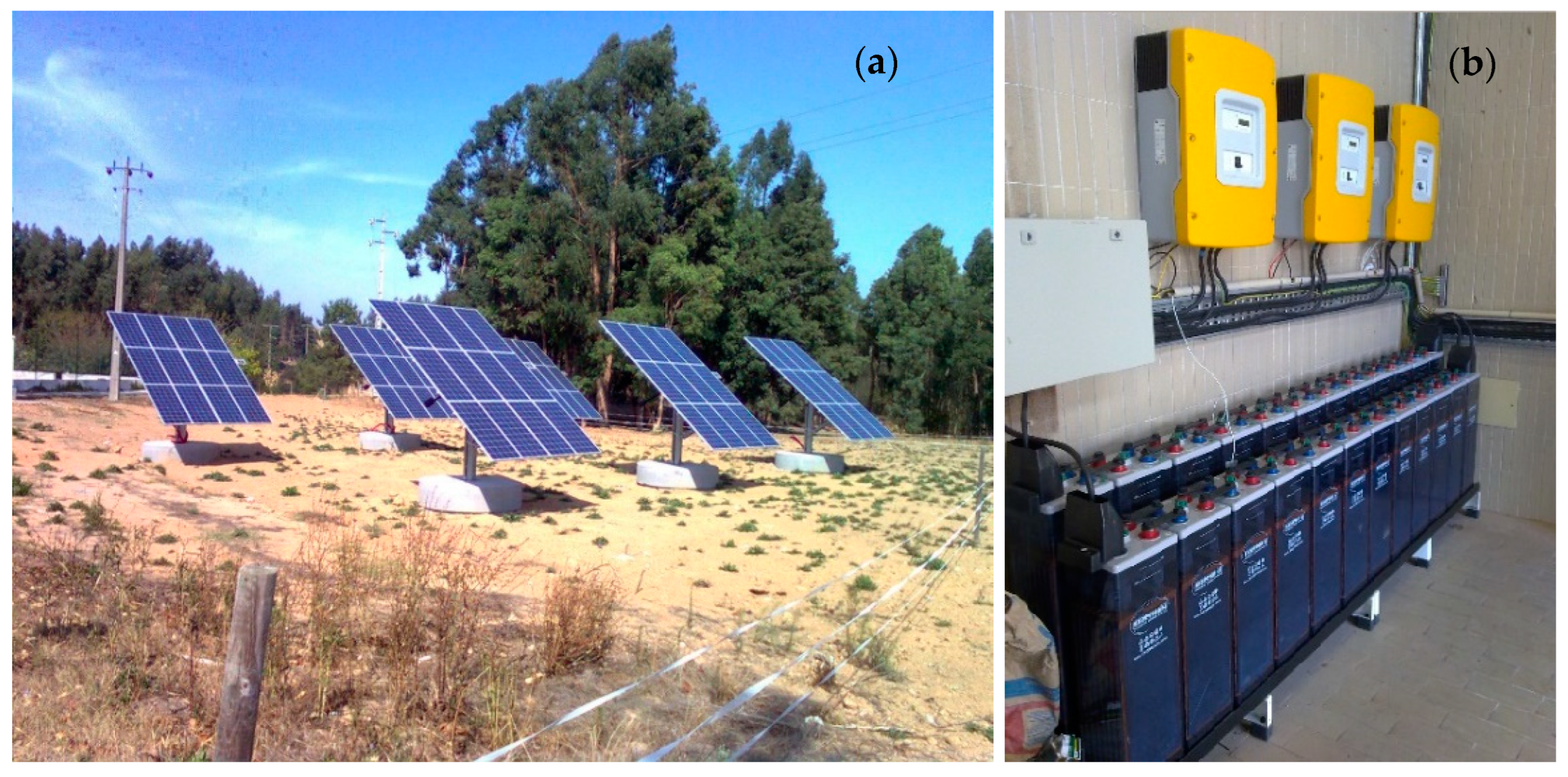
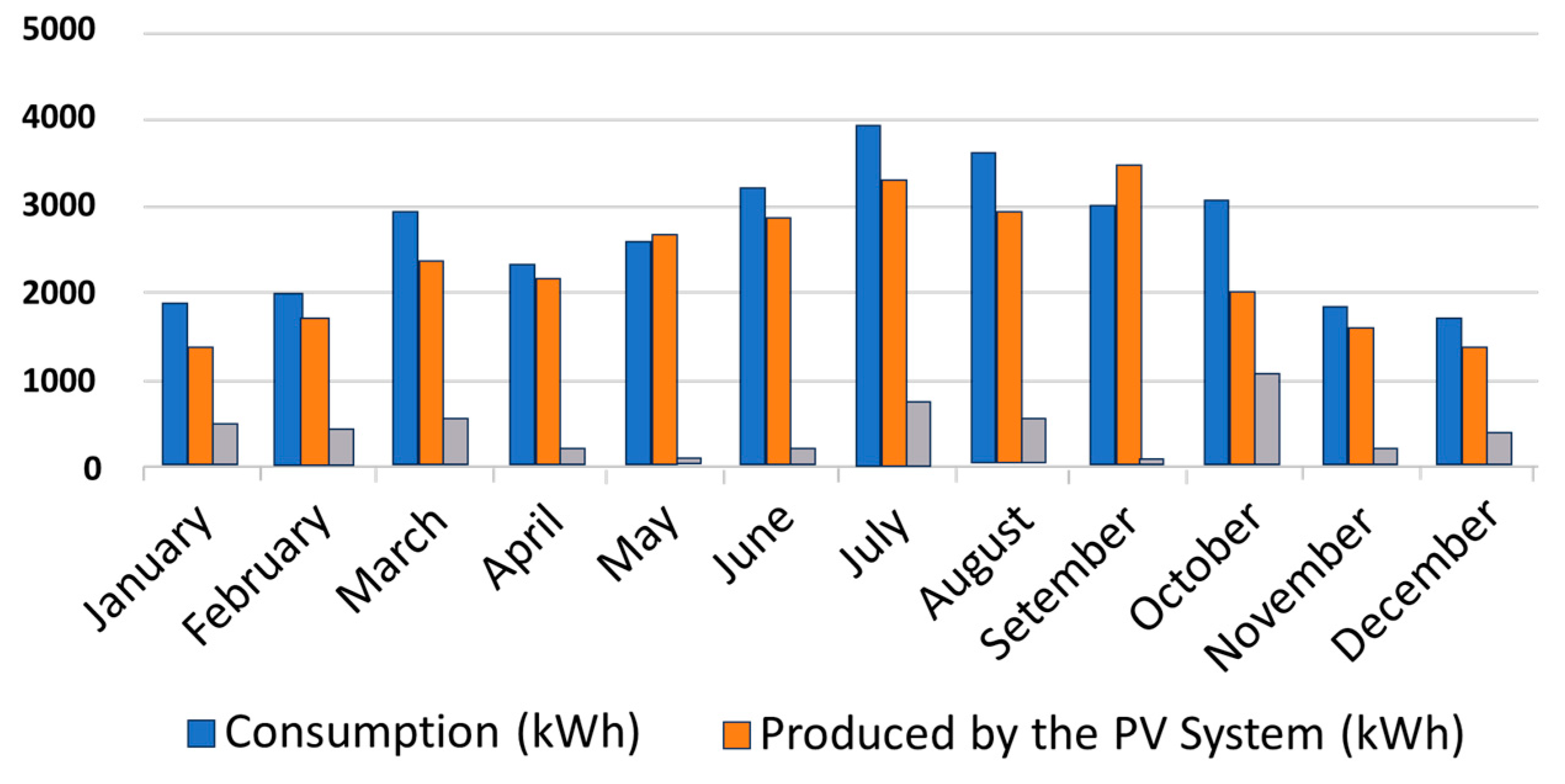
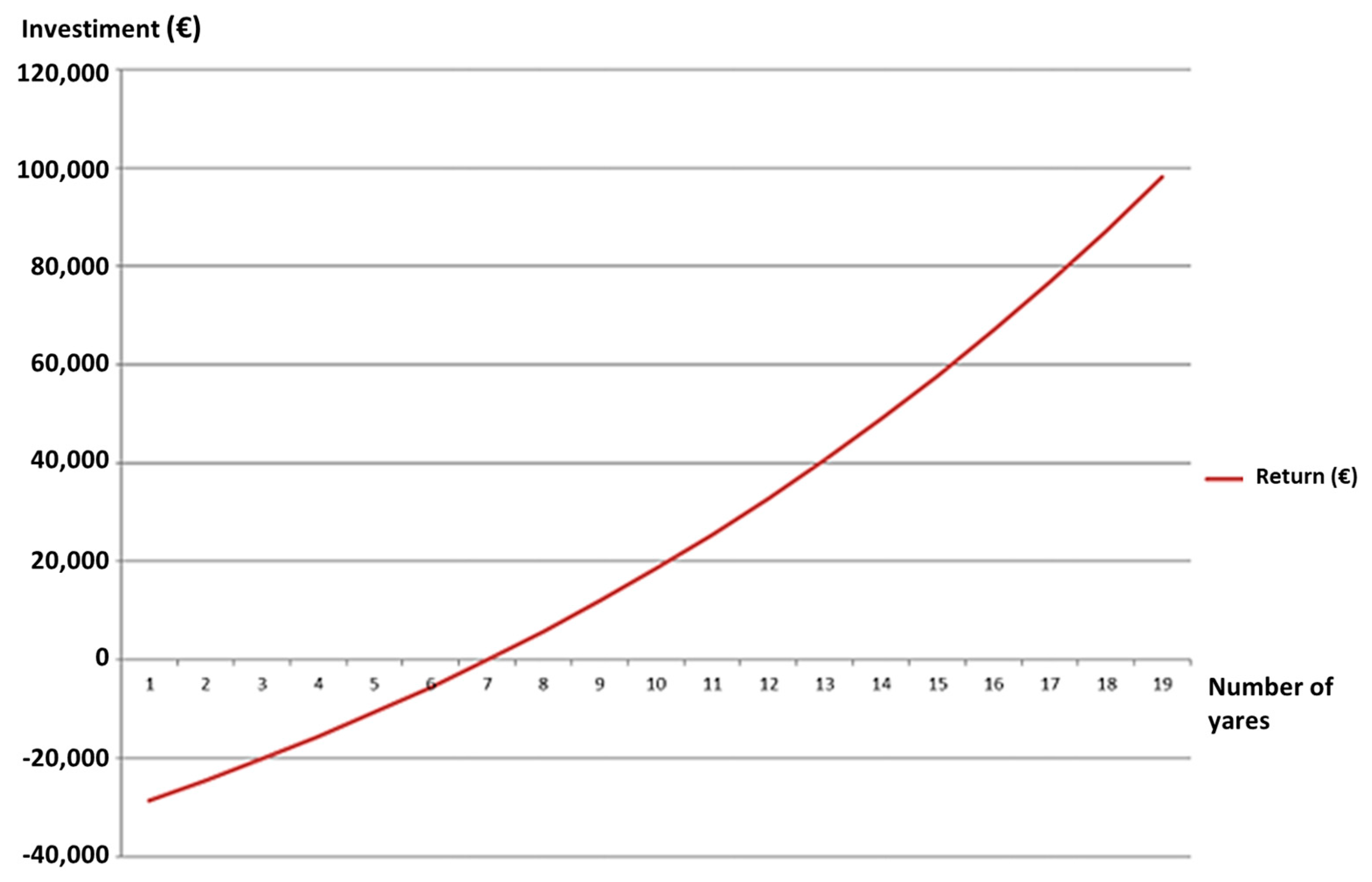
| Equipment List | Quantity |
|---|---|
| SILIKEN panels with 180 Wp peak power | 72 |
| Structure for fixing the panels to the ground, with ETTATRACK 1500 solar tracker system (for 12 panels each) | 6 |
| Sunny Boy 3800 V inverters (up to 95.6% efficiency) | 3 |
| Battery inverter (off-grid): Sunny Islands 5048 (efficiency up to 95%) | 3 |
| (3 × 8) batteries: 8OPzS 800 Elem.2 V-1166 Ah/C120 h | 24 |
| Battery shelf | 1 |
| Material earth protection system, modules, junction boxes, electrical wiring, circuit breakers, electrical panels, etc. | 1 |
| Multicluster MC-Box 6.3 | 1 |
| Monitoring option: Sunny WebBox | 1 |
| Router | 1 |
| Equipment List | System A (Case Study) | System B | System C | System D |
|---|---|---|---|---|
| Peak power of the installed photovoltaic system (Wp) | 13,000 | 56 | 24,000 | 10,000 |
| PV System—fixed or solar tracker | Solar tracker | Fixed | Fixed | Fixed |
| Energy consumption per day (kWh) | 89.43 | 121 | 54.64 | 36.2 |
| Installed battery size (Ah) | 1166 | 85 | 1202 | 1800 |
| Own production | Yes | Yes | Yes | Yes |
| Local and remote control/monitoring system ability | Yes | No | No | No |
| Prepared to include a wind generator or mini hydro | Yes | No | No | No |
| Automatic energy selection from own production or external grid network | Yes | No | No | No |
| Batteries autonomy in days for the installed power without sun | 5/6 | n.a. | n.a. | n.a. |
| Reduction energy from grid (%) | 83.24% | n.a. | n.a. | 86% |
| Percentage (%) of load rate/batteries’ autonomy for the installed power | 86 | n.a. | n.a. | n.a. |
| Type of automation (PLC or other) | Yes | No | No | No |
| System uses HMI or other equipment for monitoring and controlling the system | Yes | No | No | No |
| Automation able to optimize/reduce consumption | Yes | No | No | No |
| System must comply with the IEC 60364-7-712 standard [25] | Yes | n.a. | n.a. | n.a. |
| Peak power of the installed photovoltaic system (Wp) | 13,000 | 56 | 24,000 | 10,000 |
| PV system—fixed or solar tracker | Solar Tracker | Fixed | Fixed | Fixed |
| Energy consumption per day (kWh) | 89.43 | 121 | 54.64 | 36.2 |
| Power energy source choice with automatic control | Yes | No | No | No |
Disclaimer/Publisher’s Note: The statements, opinions and data contained in all publications are solely those of the individual author(s) and contributor(s) and not of MDPI and/or the editor(s). MDPI and/or the editor(s) disclaim responsibility for any injury to people or property resulting from any ideas, methods, instructions or products referred to in the content. |
© 2023 by the authors. Licensee MDPI, Basel, Switzerland. This article is an open access article distributed under the terms and conditions of the Creative Commons Attribution (CC BY) license (https://creativecommons.org/licenses/by/4.0/).
Share and Cite
Santos, A.A.; Pereira, F.; da Silva, A.F.; Caetano, N.; Felgueiras, C.; Machado, J. Electrification of a Remote Rural Farm with Solar Energy—Contribution to the Development of Smart Farming. Energies 2023, 16, 7706. https://doi.org/10.3390/en16237706
Santos AA, Pereira F, da Silva AF, Caetano N, Felgueiras C, Machado J. Electrification of a Remote Rural Farm with Solar Energy—Contribution to the Development of Smart Farming. Energies. 2023; 16(23):7706. https://doi.org/10.3390/en16237706
Chicago/Turabian StyleSantos, Adriano A., Filipe Pereira, António Ferreira da Silva, Nídia Caetano, Carlos Felgueiras, and José Machado. 2023. "Electrification of a Remote Rural Farm with Solar Energy—Contribution to the Development of Smart Farming" Energies 16, no. 23: 7706. https://doi.org/10.3390/en16237706
APA StyleSantos, A. A., Pereira, F., da Silva, A. F., Caetano, N., Felgueiras, C., & Machado, J. (2023). Electrification of a Remote Rural Farm with Solar Energy—Contribution to the Development of Smart Farming. Energies, 16(23), 7706. https://doi.org/10.3390/en16237706










